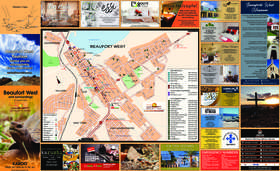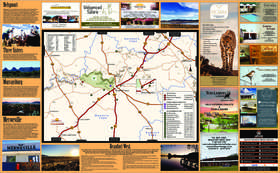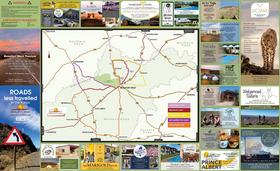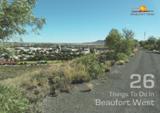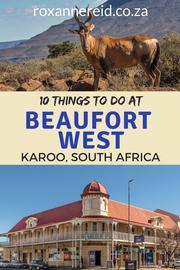Beaufort West - Place Of Pioneers
A country of hard men
Once man moved in to the section of the Karoo where Beaufort West now lies, there were constant clashes at water fountains. Water was a scarce commodity, desperately needed by both man and beast, so those who controlled the fountains controlled the land. Bushmen, predators, runaway slaves, and other law breakers, regularly plundered farm stock from the fledgling farms. Xhosa tribesmen clashed with the men on the loan farms as they needed water and grazing for their huge cattle herds. These tribesmen had moved into the Karoo after a war between two princes in the Eastern Cape.
Adventurers, explorers and big game hunters regularly passed. They were a rough and ready lot, and so were the ivory traders who fiercely guarded their heavily loaded wagons bound for the coast. Outlaws were among the first inhabitants of this area. Men were banished here after the Slagtersnek Rebellion as the Government considered the Karoo sufficiently isolated to stop them causing further trouble. They established themselves in the harsh arid world of the Nuweveld Mountains. Smuggling was rife: arms, ammunition and liquor, in particular, fetched top prices and were in continuous demand. The missionaries came and tried preaching against the evils of the demon drink but the hard dry land mostly defeated their efforts.
The establishment of a town
Then, in 1818, at the request of Lord Charles Somerset, then Governor of the Cape Colony, a town was established on the prize farm, Hooyvlakte, which lay in a sheltered spot, between two normally dry rivers, at the foot of the Nuweveld Mountains, so named because of the new grazing they offered. The objective was to establish and maintain law and order and bring religion and responsible government to this far flung spot.
The farmers who first settled in this arid zone were tough, able to contend with predators and regular raids on their stock. But they were also hospitable people who offered food and shelter to passing hunters, adventurers, explorers, missionaries and pedlars who brought welcome news from neighbours and the faraway Cape. Among the first farmers was a father and son, of Huguenot extraction and both widowed, who came to the area in 1760. Abraham and Jacob Le Clercq (later called De Klerk) were granted a farm which they named Hooyvlakte, because tall, waving grass on the plains reminded them of wheat fields. They built a house, remarried and travelled frequently to the Cape to sell their produce. Soon they had cleared the area of predators and developed one of the prize farms of the hinterland. It caught the eye of magistrates sent to find a viable spot for a town.
Local farmers were delighted. A magistrate and church would ease their lot. For too long they had had to read their Bibles in isolation and travel for days to marry or have their children baptised. A town represented authority, education, religious instruction and social intercourse. Yet, among them were men who did not welcome the approach of civilisation. One was Jacob de Klerk. He moved northwards across the Vall River and, in time, helped establish Klerksdorp.
Hooyvlakte had water and an adequate number of buildings. A town with huge erven was laid out. Irrigation furrows were laid so that water from the permanent fountains could be channelled to fruit and vegetable gardens. Today, irrigation furrows, which date right back to those early days, still line the streets of the old town area. Pear trees, many of which still survive, were planted for shade. The town was called Beaufort in honour of Lord Charles Somerset's father, the fifth Duke of Beaufort and a man who could trace his lineage back to the Plantagenets. A church was built. Initially it was a humble thatchroofed place of worship, but later the present superb Neogothic edifice, which has pride of place in the main street, was erected. Its spire can be seen for miles around. This was all in keeping with Lord Charles Somerset's ideas. The British liked towns to have churches and official buildings at their core.
Architectural heritage and a world famous surgeon
The town still has some good examples of early Karoo architecture among its historic homes most of which can be seen on a walk through the historic central area. Beaufort West became the first municipality in South Africa in February, 1837, and had the first town hall in the country. Today this forms part of the museum and houses a magnificent display of awards presented to surgeon Professor Chris Barnard who performed the world's first heart transplant almost 30 years ago. His father, the Reverend Adam Barnard, preached in the little church next to the town hall and the family lived in the adjacent house. Both these buildings are part of the museum and all three are national monuments.
In addition to these interesting old buildings there is a superb example of dressed stone architecture, or "snecked" masonry in the municipal offices.This free style architecture was popular at the turn of the 20th century and is one of the tourist attractions of the town. It was built as the Girls' Public School. More of this dressed stonework, so much of which was done in the Karoo by Scottish stone masons, can be seen at Christ Church Anglican Church, a Neogothic style building, designed by Sophie Grey, wife of the first Bishop of Cape Town, Rev. Robert Grey who designed many of the churches on the platteland.
A very special landmark
The jail, which stands in the middle of the main road and the N1 is a landmark on the north/south route, and at one stage, there was a gallows nearby. One of the first wardens was incarcerated in his own jail after a jailbreak. However, security must have been suspect, because he managed to escape never to be seen again.
The old Anglo-Boer War blockhouse still guards the red railway bridge. Built of local Karoo stone, it is a silent reminder of "The last of the Gentlemen's Wars". Boer and British soldiers are buried in the town cemeteries. There is also a monument in the mountains to those killed when a donkey convoy en route to Fraserburg was ambushed by the Boers. The stone wall, around the town cemetery is the result of a community effort and has been declared a national monument.



